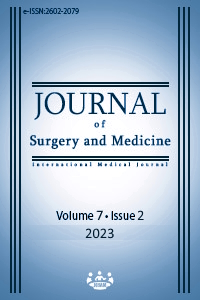Prenatal gymnastics and psychological support benefit pregnant women
Pregnant women: Gymnastics and psychological support
Keywords:
prenatal gymnastics, psychological support, pain, walking, anxiety, self-esteemAbstract
Background/Aim: The management of pregnant women is a significant public health concern. This study aims to demonstrate the benefits of prenatal gymnastics and psychological support on pain, walking, anxiety, and self-esteem during pregnancy.
Methods: A quasi-experimental study was conducted over eight months, from September 2020 to April 2021, with 38 pregnant women participating. They underwent 16 sessions of prenatal gymnastics and psychological support once a week, lasting 45 min at low to moderate intensity. Pain, six-minute walk, anxiety, and self-esteem were measured using the visual analog scale (VAS), the six-minute walk test, the Hospital Anxiety and Depression Scale (HAD Scale), and the Rosenberg scale, respectively. The parametric Student's t-test and chi-square were used to compare quantitative and qualitative variables before and after the program, with P<0.05 considered statistically significant.
Results: The study found that the distance traveled (377.45 m vs. 393 m; P=0.001) and VO2max (15.1 ml/kg/m2 vs. 18.5 ml/kg/m2; P=0.001) increased at the end of the program. However, pain (6 vs. 1.16; P=0.001) and walking speed (2.2 m/s vs. 1.9 m/s; P=0.001) decreased. The program also improved self-esteem (low: 55.3% before vs. 0% after; P=0.001, medium: 44.7% before vs. 13.2% after; P=0.001, strong: 0% before vs. 86.8% after; P=0.001) and anxiety (Uncertain anxiety: 31.6% before vs. 97.4% after; P=0.001, Questionable anxiety: 50% before vs. 2.6% after, Certain anxiety: 18.4% before vs. 0% after; P=0.001).
Conclusion: Regular prenatal gymnastics and psychological support positively affect oxygen consumption, pain, anxiety, and self-esteem among pregnant women. This program should be provided continuously to minimize pregnancy-related complications.
Downloads
References
Liddle SD, Pennick V. Interventions for preventing and treating low back and pelvic pain during pregnancy Cochrane. Database Syst. Rev. 2015;54(8):574-80. DOI: https://doi.org/10.1002/14651858.CD001139.pub4
Aldabe D, Ribeno DC, Milosaljevics, Dawn Bussey M. Pregnancy-related pelvic girdle pain and its relationship with relaxing levels during pregnancy a systematic review. European Spine J. 2012;21(9):1769-76. DOI: https://doi.org/10.1007/s00586-012-2162-x
Sinclair M, Close C, McCullough JEM, Hughes C, Liddle SD. How do women manage-pregnancy related low back and for pelvic pain Descriptive findings from an online survey. Evidence Based Midwifery. 2014;12(3):76-82.
Dumas G.A, Reid JG, Wolfe LA, Griffin MP, MC Grath MJM. Exercises, posture and back pain during pregnancy. Part J Clin Biomech. 1995;10(2):106-9. DOI: https://doi.org/10.1016/0268-0033(95)92047-P
Ostgaard HC, Andersson GBJ, Karlsson K. Prevalence of back pain in pregnancy. Spine. 1991;16(5):549-52. DOI: https://doi.org/10.1097/00007632-199105000-00011
Kristiansson P, Svardsudd K, Schoultz VB. Symphyseal pain, and back pain during pregnancy. Am J. Obstet Gynecol. 1996;175(34):1342-47. DOI: https://doi.org/10.1016/S0002-9378(96)70052-2
Nahed M, Ezmerli MD. Exercise in pregnancy. Prim care update for Ob/Gyns. 2000;7(5):260-5. DOI: https://doi.org/10.1016/S1068-607X(00)00056-1
Ageron C. Another way of looking at low back pain during pregnancy. 2000.
Lacouara C. Ten good reasons to walk during pregnancy. March, 2017.
Dayan J. Clinic and epidemiology of anxiety and depressive disorders of pregnancy and postpartum. J of Obst Gyn and Reproductive Biology, Masson. 2007;35(9):120-6.
Capponi C, Horbacz. About the indivisibility of perinatal anxiety. Psych Perspectives. October-December 2007;78(14):43-9.
Connect JP. Love him before he is born. Robert Lafond. Responses collection, 1993.
Delassus JM. The meaning of motherhood, 1997.
Valors M-H. The psychological side of childbirth, Article n°289, December 2000.
Leifer M. Psychological changes accompanying pregnancy and motherhood. Genet Psychol Monog, 1977;95(78):55-96.
Cleeland CS, Ryan KM. Pain assessment global use of the brief Pain inventory. Ann Acad Med Singapore. 1994;23(6):129-38.
Enright PL, Sherill DL. Reference equations for the six-minute walk in healthy adults. Am J Respir Crit Care Med. 1998;158(69):1384-7. DOI: https://doi.org/10.1164/ajrccm.158.5.9710086
Zigmond AS, Smaith RP. The hospital anxiety and depression scale. Acta Psychiatr Scand. 1983;67(36):1-370. DOI: https://doi.org/10.1111/j.1600-0447.1983.tb09716.x
Teichman Y. Expectant parenthood. In S-Fisher and J. Reason (Eds), Handbook of life stress. Cognition and health. 1988;18(7):3-22.
Rosenberg and Ekilium, Test of the self-esteem scale. 1965. DOI: https://doi.org/10.1037/t01038-000
Lawani MM, Alihonou E, Akplogan B, Poumart G, Okou L. The effect of prenatal gymnastics on childbirth: a study on 50 sedentary Beninese women during the 2nd and 3rd trimesters of pregnancy. Health. 2003;13(4):235-41.
Sternfeld B, Qeensberry CP, Eskenazi B, Vewman LA. Exercise during pregnancy and pregnancy outcome. Med Sci Sports Exercise. 1995;27(3):634-40. DOI: https://doi.org/10.1249/00005768-199505000-00004
Elden H, Ladfords L, et al. Effects of acupuncture and stabilising exercises as adjunct to standard treatment in pregnant women with pelvic girdle pain: randomized single blind controlled trial. UPKOGRP, March, 2005. DOI: https://doi.org/10.1136/bmj.38397.507014.E0
Garshasbi, A, Zadech SF. The effect of exercise on the intensity of low back pain in pregnant women. Int J Gynecol Obstet, 2005;88(10):271-5. DOI: https://doi.org/10.1016/j.ijgo.2004.12.001
Uhlendorf, D. Reference values for cardiopulmonary exercise testing for sedentary and active men and women. Arq Bras Cardiol. 2011;96(16):54–9. DOI: https://doi.org/10.1590/S0066-782X2010005000155
Chantrain VA, Reychler G. Evaluation of exercise tolerance in pregnant and postpartum women. Revue de Physiothérapie. 2015;15(8):168-75. DOI: https://doi.org/10.1016/j.kine.2015.09.010
Downloads
- 512 606
Published
Issue
Section
How to Cite
License
Copyright (c) 2023 Fraçois Njimbu , Iness bilo, Andy-Muller Nzinga, Teddy Bofosa , Eric Kam , Augustin Buhendwa , Vicky Lokomba , Roger Mbungu , Jacques Zandibeni, Betty Miangindula
This work is licensed under a Creative Commons Attribution-NonCommercial-NoDerivatives 4.0 International License.
















